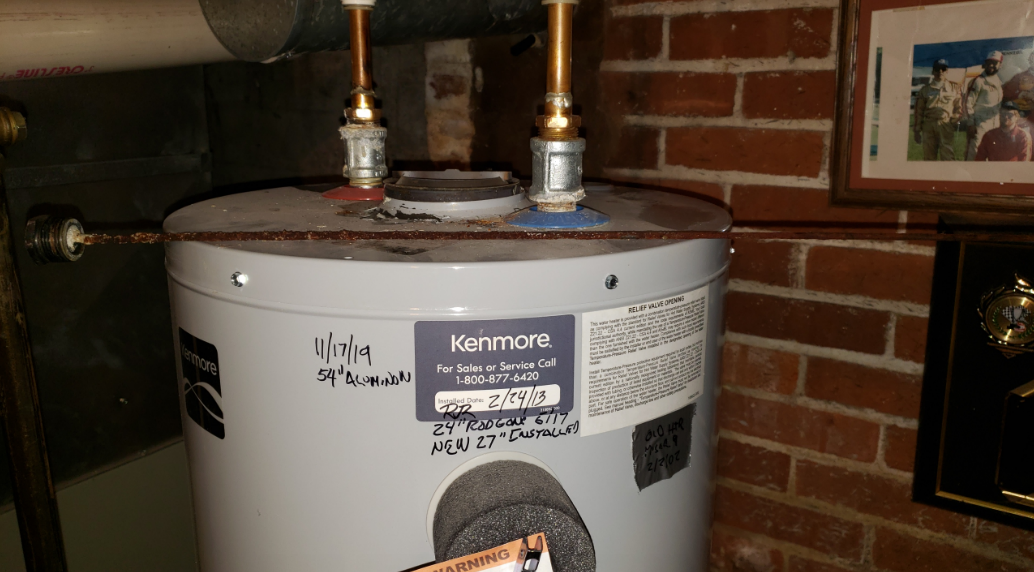 "RacinBob" (racinbob)
"RacinBob" (racinbob)
11/17/2019 at 18:19 ē Filed to: None
 1
1
 17
17
 "RacinBob" (racinbob)
"RacinBob" (racinbob)
11/17/2019 at 18:19 ē Filed to: None |  1 1
|  17 17 |
I am hoping I will get better than 10 years out of the heater this time.....
Heater was installed in 2013. The original e lectrode gone in 2017. The replacement was gone and r eplaced today. PS - Sears is gone too come to think of it......

 shop-teacher
> RacinBob
shop-teacher
> RacinBob
11/17/2019 at 18:40 |
|
You don't have a dielectric union on your water lines. That's a problem.
 ranwhenparked
> RacinBob
ranwhenparked
> RacinBob
11/17/2019 at 18:48 |
|
The writing on my shows that it was installed in 1991, so Iím counting the days till it fails. Not sure if meticulous maintenance by previous owners, or if they just never took showers.
Also, Sears Home Improvement is still in business, they go by Transform †Home Improvements now, and I understand they tend to be pretty cheap, but the service seems to be terrible. I had them scheduled to give an estimate on replacing my 36 year old central a/c system, and they rescheduled or blew me off 4 times over the course of 3 months, until I told them to just forget it and Iíll deal with it next year.†
 MM54
> RacinBob
MM54
> RacinBob
11/17/2019 at 18:51 |
|
This is one of those things I need to do and never remember to do it.
 My X-type is too a real Jaguar
> RacinBob
My X-type is too a real Jaguar
> RacinBob
11/17/2019 at 19:40 |
|
Mine looked like it spent time on the T
itanic after 17 years, replaced
it with one with a 10 year warranty.
 Tekamul
> shop-teacher
Tekamul
> shop-teacher
11/17/2019 at 19:57 |
|
Sure he does.

Zinc outside, plastic inside. At least thatís what that looks like.† Hard to tell without being able to be there.
 shop-teacher
> Tekamul
shop-teacher
> Tekamul
11/17/2019 at 21:49 |
|
Looks like a galvanized union going straight to threaded copper to me. I s ay that as someone who has made that mistake before.
 oldmxer
> RacinBob
oldmxer
> RacinBob
11/18/2019 at 00:33 |
|
hardness of water in our area means new water heater every few years, when the lime gets up to the bottom element weíre done
 RacinBob
> shop-teacher
RacinBob
> shop-teacher
11/18/2019 at 07:38 |
|
Oh, I am that installed it 6 years ago. as well as the one before it. What should I have done different?
 RacinBob
> oldmxer
RacinBob
> oldmxer
11/18/2019 at 07:40 |
|
Mine I noticed is starting to pop when heating which I believe if due to lime insulating the bottom. Meaning I suspect its days are numbered.†
 Michael
> RacinBob
Michael
> RacinBob
11/18/2019 at 09:12 |
|
Something like this may keep the two materials from touching each other
Holy shit URL, get under control
 shop-teacher
> RacinBob
shop-teacher
> RacinBob
11/18/2019 at 09:16 |
|
A dielectric union is a coupling with a plastic sleeve that separates the copper from the galvanized. It keeps the two dissimilar metals from reacting.
Hereís a link to a couple versions from Menards.
 RacinBob
> shop-teacher
RacinBob
> shop-teacher
11/18/2019 at 13:30 |
|
You are correct itís black iron, g alv union, and then copper . Here is an interesting thread on dielectric unions . Given the plumbers concerns, I think I will just maintain my electrodes.
 RacinBob
> My X-type is too a real Jaguar
RacinBob
> My X-type is too a real Jaguar
11/18/2019 at 13:33 |
|
My favorite observation is a 10 year old water heater is a lot heavier than a brand new one.......
 shop-teacher
> RacinBob
shop-teacher
> RacinBob
11/18/2019 at 14:05 |
|
The link didnít come through, but Iím interested.
 RacinBob
> shop-teacher
RacinBob
> shop-teacher
11/18/2019 at 21:50 |
|
My bad.... https://www.reddit.com/r/askscience/comments/35ypgu/why_do_plumbing_dielectric_unions_always_fail/
 shop-teacher
> RacinBob
shop-teacher
> RacinBob
11/18/2019 at 22:30 |
|
Interesting . I havenít experienced any of these failures, but Iíve only been a homeowner for not quite a decade, and am trained as a carpenter not a plumber, so my data set is small.
 RacinBob
> shop-teacher
RacinBob
> shop-teacher
11/18/2019 at 22:38 |
|
I guess I figure I can afford changing the electrode every two or three years, though I am beginning to think lime build up will get it at about the same point as electrolytic failure would of. .....
Chalk it up to just another science experiment.....